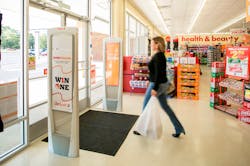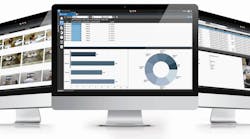Video and RFID: A Perfect Match
Combining surveillance video with analytics, transaction data and other business data is an approach more organizations are taking to gain operational insights and improve efficiency and performance.
Certainly, the concept of marrying video and data is not new to the many systems integrators working hard to stay current with technology advances so they can advise customers and help them solve business challenges more successfully. That is one reason why the concept of integrating radio frequency identification (RFID) data with video is gaining traction so quickly. The solution offers organizations – especially retailers – an effective tool for tracking assets, safeguarding costly objects and merchandise, investigating suspected theft and better managing inventory.
For integrators, a solution that integrates high-definition video and RFID data represents a new opportunity to help customers improve ROI by leveraging the video and RFID technologies they may already have in place. It also enables forward-thinking integrators to expand their portfolios to drive business with new and existing customers in markets starting from retail and beyond.
RFID Basics
RFID tags, sometimes referred to as RFID chips, contain electronically stored data that is transmitted via radio waves whenever a tagged item passes by a fixed RFID reader. The stored data can consist of almost any information an organization requires – including item or serial numbers, vehicle identifiers or electronic product codes, making it extremely useful for inventory tracking and management.
There are billions of RFID tags deployed in retail apparel alone, with estimates suggesting just 15 percent of that addressable market has been served to date. The total value of the RFID market is expected to approach more than $18 billion by 2026, according to IDTechEx Research.
RFID technology is different from Electronic Article Surveillance (EAS), which most people recognize as the often bulky or hard plastic tags attached to clothes and other merchandise in retail stores. EAS tags contain no item-specific data and are designed to simply trigger an alarm if they are not removed or deactivated. While some predict that RFID technology will eventually replace EAS, another approach is to combine the two capabilities so organizations can access valuable item-specific data as well as maintain the alarm functionality.
On its own, RFID technology is being used quite effectively in a wide range of applications. Renowned guitar maker Fender has reportedly embedded more than 30,000 RFID chips to uniquely identify its guitars. The data can be read by Fender dealers and repair shops, and if a guitar is believed to be stolen, it can also be read by police to help determine the instrument’s real owner.
Casinos are using RFID data embedded in gambling chips to track spending and prevent theft; factories are using it to help measure how long it takes to build a product; and of course retailers – both large and small – are increasingly deploying RFID tags for inventory tracking, loss prevention and more.
RFID tags are also helpful when it comes to verifying authenticity – whether a $20,000 limited edition Stratocaster, a $100 casino chip or a $2,000 Louis Vuitton handbag.
Marrying Video and RFID
Why add video to the mix when RFID is being used and deployed on its own already? While RFID, transaction and other data can help identify what has likely happened, only video can reveal how it happened and who was involved.
For example, a retailer will be able to discover that a missing RFID-tagged 4K television was last detected by a reader mounted at the backdoor in one of its locations. The assumption will probably be that the item has been stolen; however an integrated video and RFID solution can provide the next level of detail, enabling the retailer to search on the electronic product code (EPC) contained in the RFID tag and click on a link to view the associated video. The recorded video may show that an employee passed the television out the backdoor to an unknown person.
It would enable the retailer to verify that the item was, in fact, stolen and provide clear video evidence that could be used to identify the unknown participant, deal with the thieving employee and recover the cost of the lost item.
The applications for integrated video and RFID data are numerous, and systems integrators will discover that customers are quick to suggest additional uses once they understand the capabilities of the solution. Interesting customer suggestions we have encountered include using video and RFID data to:
- track and manage pharmaceutical distribution;
- protect valuable antiques and artwork in high-end banking branches; and
- confirm that high-end merchandise is intact at the moment it is transferred to a courier company for fulfillment delivery, in case items arrive damaged.
These are just a few examples of how an integrated video and RFID data solution can be used, as the applications are almost limitless.
Product Considerations
To ensure optimum flexibility and performance, systems integrators should look for solutions that include easy-to-use reporting software with robust search capabilities that enable customers to run searches across a few or thousands of locations simultaneously. Automated alerts that enable organizations to proactively respond to anomalies – such as high-value items being removed from a location without first being captured on an order – are also ideal.
It is also important for systems integrators to think about the upfront preparation they will need to confidently propose integrated video and RFID solutions to customers and guide them through the adoption process. The solution they choose to adopt should come with technology expertise and support on both video and RFID systems, and offer certification training that is not unnecessarily onerous. Most integrators have a high degree of knowledge on one side or the other.
Now is the perfect time for systems integrators to start educating themselves on video and RFID integration. Adding this expertise will enable your organization to build a new competency that addresses a high-growth market. It will enable integrators to provide a differentiated offering to customers, along with the advice and expertise that they are looking for to help them compete more effectively.
Jeff Corrall is the integrations business development manager for March Networks. The company’s Searchlight for Retail-RFID Solution (www.securityinfowatch.com/12033948) was recognized as the SIA New Product Showcase winner at ISC West 2017. Request more info about the company at www.securityinfowatch.com/10214308.




